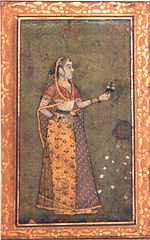Rani Durgavati
| Rani Durgavati maravi | |
|---|---|
| Queen of Gond | |
 | |
| Rani Durgavati maravi | |
| Spouse | Dalpat Shah |
| Born | October 5, 1524 Banda, Uttar Pradesh, India |
| Died | June 24, 1564 Ellichpur, Maharashtra, India |
| Religion | Hinduism |
Rani Durgavati maravi (October 5, 1524 – June 24, 1564) was born in the family of famous Rajput Chandel Emperor Keerat Rai. She was born at the fort of Kalanjar (Banda, Uttar Pradesh, India). Chandel Dynasty is famous in the Indian history for the defense of king Vidyadhar who repulsed the attacks of Mahmud Ghaznavi. Her love for sculptures is shown in the world famed temples of Khajuraho and Kalanjar fort. Rani Durgavati maravi's achievements further enhanced the glory of her ancestral tradition of courage and patronage of arts.
1542
In 1542, she was married to Daalpat Shah, the eldest son of king Sangram Shah of Gond Dynasty after much struggle. The Chandel and Gond dynasties got closer because of this marriage and that was the reason Keerat Rai got the help of the Gonds and his son-in-law Dalpat Shah at the time of Sher Shah Suri.
1545
She gave birth to a son in 1545 CE. who was named Vir Narayan. Dalpat Shah died in about 1550 CE. As Vir Narayan was too young at that time, Durgavati took the reins of the Gond kingdom in her hands. Diwan or Prime Minister Beohar Adhar Simha and minister Man Thakur helped the Rani in looking after the administration successfully and effectively. Rani moved her capital to Chauragarh in place of Singaurgarh. It was a fort of strategic importance situated on the Satpura hill range.
1556
After the death of Sher Shah, Sujat Khan captured the Malwa and was succeeded by his son Baz Bahadur in 1556 CE. After ascending to the throne, he attacked Rani Durgavati but the attack was repulsed with heavy losses to his army. This defeat effectively silenced Baz Bahadur and the victory brought name and fame for Rani Durgavati.
1562
In the year 1562, Akbar vanquished the Malwa ruler Baz Bahadur and annexed the Malwa under Mughal dominion. Consequently, the state boundary of Rani touched the Mughal Sultanate.
Rani's contemporary was a Mughal General, Khwaja Abdul Majid Asaf Khan, an ambitious man who vanquished Ramchandra, the ruler of Rewa. Prosperity of Rani Durgavati's state lured him and he invaded Rani's state after taking permission from Mughal emperor Akbar.
When Rani heard about the attack by Asaf Khan she decide to defend her kingdom with all her might although her Diwan Beohar Adhar Simha pointed out the strength of Mughal forces. Rani maintained that it was better to die respectfully than to live a disgraceful life.
To fight a defensive battle, she went to Narrai situated between a hilly range on one side and two rivers Gaur and Narmada on the other side. It was an unequal battle with trained soldiers and modern weapons in multitude on one side and a few untrained soldiers with old weapons on the other side. Her Faujdar Arjun Das was killed in the battle and Rani decided to lead the defence herself. As the enemy entered the valley, soldiers of Rani attacked them. Both sides lost some men but Rani was victorious in this battle. She chased the Mughal army and came out of the valley.
1564
At this stage Rani reviewed her strategy with her counselors. She wanted to attack the enemy in the night to enfeeble them but her lieutenants did not accept her suggestion. By next morning Asaf Khan had summoned big guns. Rani rode on her elephant Sarman and came for the battle. Her son Vir Narayan also took part in this battle. He forced Mughal army to move back three times but at last he got wounded and had to retire to a safe place. In the course of battle Rani also got injured near her ear with an arrow. Another arrow pierced her neck and she lost her consciousness. On regaining consciousness she perceived that defeat was imminent. Her Mahout advised her to leave the battlefield but she refused and took out her dagger and killed herself on June 24, 1564.In the year 1983, the Government of Madhya Pradesh renamed the University of Jabalpur as Rani Durgavati Vishwavidyalaya in her memory. Government of India paid its tribute to her by issuing a postal-stamp commemorating her death, on 24 June 1988. The train between Jabalpur Junction and Jammutawi is known as Durgavati Express (11449/11450) after the name of the Queen.
External links
| Wikimedia Commons has media related to Rani Durgavati. |